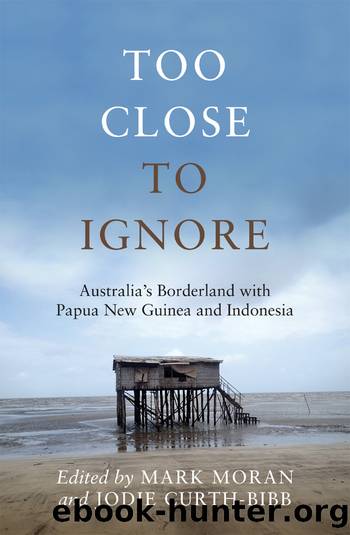Too Close to Ignore by Mark Moran & Jodie Curth-Bibb

Author:Mark Moran & Jodie Curth-Bibb
Language: eng
Format: epub
ISBN: 9780522875485
Publisher: Melbourne University Press
Australiaâs extrajurisdictional influence in PNG
Joint management
A distinct feature of governance in the border area is how the influence of the Australian state (whether intended or inadvertent) extends beyond its border. The large number of agencies active in the Torres Strait, and the level of resourcing that they enjoy, sit in stark contrast to the lack of resources on the PNG side. In the Torres Strait, at a local government level, the Torres Strait Island Regional Council covers all of the land and sea territory in the Protected Zone under the treaty. At regional level, the Torres Strait Regional Authority is a statutory authority under the Australian legislation. At the state level, multiple Queensland state government departments that are active in regional areas, including health, police, education, justice and housing. At the Commonwealth level, there are four key Australian government border authorities: Department of Foreign Affairs and Trade (DFAT), which administers the treaty; Department of Agriculture and Water Resources (DAWA) with responsibility for biosecurity; Australian Border Force (ABF; within the Department of Home Affairs) for border enforcement; and Australian Fisheries Management Authority (AFMA). In addition, the Australian Federal Police (AFP) plays an intelligence role, the Australian Defence Force (ADF) assists with reconnaissance; and the Australian Marine Safety Authority (ASMA) oversees boating safety. The Maritime Border Control in Canberra controls both ADF and ABF vessels and aircraft, including a âcutterâ vessel, two âfast response boatsâ and two helicopters.38
A bewildering number of cross-border committees oversee the administration of the treaty. The central body is the Joint Advisory Committee (JAC), comprising senior representatives from the Australian and PNG governments and the Queensland and Western Provincial governments, and traditional inhabitants from the Torres Strait Islands and PNG Treaty villages. It is in turn supported by four bilateral committees that meet annually or biannually: the Traditional Inhabitants Meeting (TIM), Fisheries Bilateral Meeting, the Environmental Management Committee, and the Health Issues Committee (HIC). DFAT then coordinates the Torres Strait Interdepartmental Meeting, which aims to progress the action items arising from the JAC and these four committees.
The JAC reports to the Senior Officials Meeting and Bilateral Security Dialogue (co-chaired by the DFAT Secretary and their PNG counterpart) with representatives from a range of Australian and PNG governmentsâ law enforcement, immigration, customs, biosecurity and health entities. Its recommendations then go to the PNGâAustralia Ministerial Forum (with the Foreign Affairs ministers of PNG and Australia attending), at the highest level of bilateral relations between the two states, where highly political issues like refugee processing on Manus Island are also discussed.39
There are few, if any, opportunities for external observers and academic researchers to observe what occurs in the JAC and at these higher-level bilateral meetings, and documents were not available to the research team. An investigation in 2019 by the Australian National Audit Office (ANAO) found that JAC and subcommittee meetings were held regularly and were well attended, with outcomes being documented and actions followed up. But it noted the lack of transparency, calling for DFAT to keep a register of JAC decisions and to share it with government stakeholders.
Download
This site does not store any files on its server. We only index and link to content provided by other sites. Please contact the content providers to delete copyright contents if any and email us, we'll remove relevant links or contents immediately.
What's Done in Darkness by Kayla Perrin(25493)
Shot Through the Heart: DI Grace Fisher 2 by Isabelle Grey(18209)
Shot Through the Heart by Mercy Celeste(18153)
The Fifty Shades Trilogy & Grey by E L James(17768)
The 3rd Cycle of the Betrayed Series Collection: Extremely Controversial Historical Thrillers (Betrayed Series Boxed set) by McCray Carolyn(13182)
The Subtle Art of Not Giving a F*ck by Mark Manson(12898)
Scorched Earth by Nick Kyme(11823)
Stepbrother Stories 2 - 21 Taboo Story Collection (Brother Sister Stepbrother Stepsister Taboo Pseudo Incest Family Virgin Creampie Pregnant Forced Pregnancy Breeding) by Roxi Harding(11019)
Drei Generationen auf dem Jakobsweg by Stein Pia(10211)
Suna by Ziefle Pia(10180)
Scythe by Neal Shusterman(9251)
International Relations from the Global South; Worlds of Difference; First Edition by Arlene B. Tickner & Karen Smith(8600)
Successful Proposal Strategies for Small Businesses: Using Knowledge Management ot Win Govenment, Private Sector, and International Contracts 3rd Edition by Robert Frey(8407)
This is Going to Hurt by Adam Kay(7682)
Dirty Filthy Fix: A Fixed Trilogy Novella by Laurelin Paige(6445)
He Loves Me...KNOT by RC Boldt(5798)
How to Make Love to a Negro Without Getting Tired by Dany LaFerrière(5369)
Interdimensional Brothel by F4U(5299)
Thankful For Her by Alexa Riley(5149)
